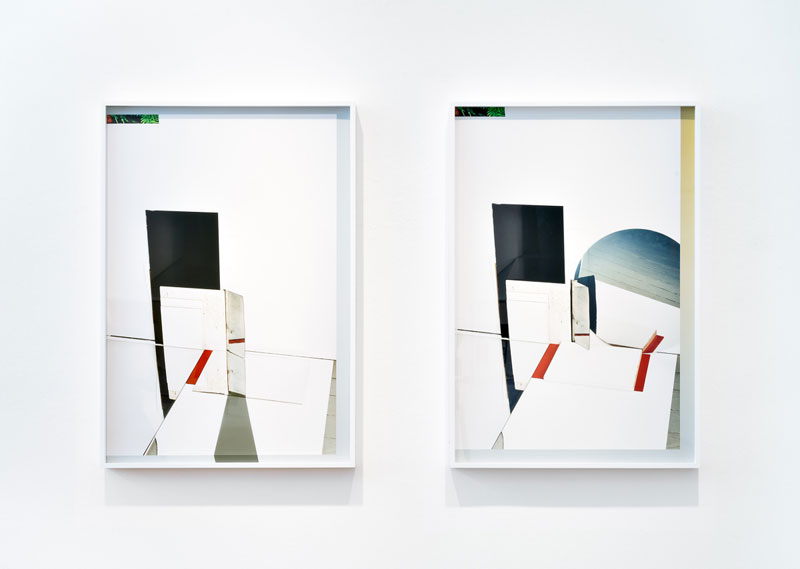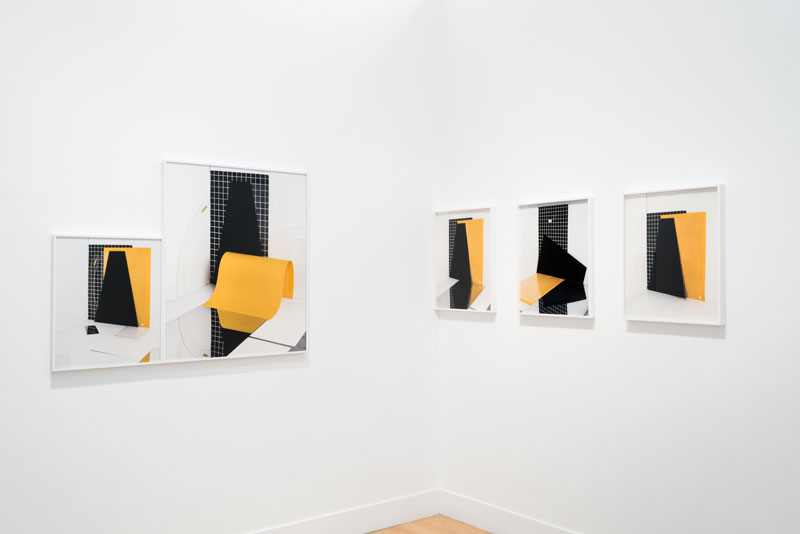
artpractical.com
July 2, 2015

Phillip Maisel. The Perfect Copy, 2015; installation view, Gregory Lind Gallery, San Francisco. Courtesy of Gregory Lind Gallery, San Francisco.

Phillip Maisel. Feldspar (1095), 2015, and Feldspar (1098), 2015; archival pigment prints; 26 x 17 3/4 in. each. Courtesy of Gregory Lind Gallery, San Francisco.

Phillip Maisel. Summer Picnic (1442), 2015 (detail); cut archival pigment print; 21 1/2 x 17 3/4 in. Photo: Zachary Royer Scholz

Phillip Maisel. Summer Picnic series, 2015; installation view, Gregory Lind Gallery, San Francisco. Courtesy of Gregory Lind Gallery, San Francisco.
Review: The Perfect Copy
By Zachary Royer Scholz
The works included in Phillip Maisel’s rigorous and thoughtful exhibition The Perfect Copy balance delicately between sculpture, installation, photography, and collage. To make the works, Maisel deftly positioned and photographed modest stacks and piles of materials, then playfully reworked the resulting images to create multifaceted pieces in which dynamic flux is temporarily frozen into precise, harmonic relationships.
Maisel’s works are both friendly and somber. Their graphic angularity is energetic yet subdued, and the bright pops of color that punctuate them are cheerful but slightly melancholic. The combination is reminiscent of Piet Mondrian’s grid-based paintings from the 1920s and 1930s, and even more akin to Kazimir Malevich’s Suprematist compositions from around 1915. However, unlike Mondrian and Malevich, who both obsessed over pure color, form, and emotion divorced from physical existence, Maisel’s works are built from real things that carry with them particular histories and uses.
The materials Maisel has favored are all loosely tied to photography. He has taken light filters, mirrors, layout boards, negative holders, photographic prints, and other mainly rectilinear forms and carefully propped them against walls or in corners in compositions that may seem casual, but in fact are precisely choreographed. He photographed these arrangements, then repeatedly repositioned, inserted, or removed elements, and photographed them again and again. It is unclear how many iterations any set of material went through, but the numerical parentheticals in Maisel’s titles suggest that what we are seeing is perhaps just the carefully curated tip of a photographic iceberg.
The resulting images sometimes stand alone, but most have been altered further through digital and physical collage techniques. These clever manipulations produce subtle nuances that can sometimes hide in plain sight. I thought I understood the seemingly straightforward trio of works Summer Picnic (1442), Summer Picnic (1443), and Summer Picnic (1472) (all 2015), but then looked closer and noticed that the edges where the yellow and black planes overlapped in the photographs had been sliced open, and a different mottled black-and-white surface was just barely visible through the slim gap. A closer look at the other works reveals that nearly all of them contain different, though equally subtle and subversive, manipulations. The Summer Picnic works have their secret slits, the Feldspar series (2015) is overlaid with nearly invisible digital and physical additions, and the linear blue forms in the Palomar Mountain works (2015) protrude unexpectedly beyond their otherwise-rectangular boundaries.
These visual nuances are fun to discover but also carry with them deeper conceptual weight. Maisel’s insertions and interventions introduce physical layers into situations that are already optically and spatially dense, and in doing so create ruptures that stitch together pictorial and physical space. These new intermeshed amalgams confound pictorial expectations, linking the past to the present and the image to the space it occupies. The complex, intercut connections not only open the works to outside influences, but also allow them to exert influence beyond their frames’ boundaries.
Framed works are usually hung, lit more or less uniformly, and kept from interacting with each other or with the space around them. But Maisel turns this on its head by extending the hybrid spatial logic within his works to their placement and installation in the gallery. The five works in the Feldspar series are scattered across three different walls and cannot all be seen at the same time. The six works in Palomar Mountain are hung in a dense grid, two across by three down, whose bottom edge rests on the gallery’s low, wide, white baseboard. The stand-alone Serengeti Green (1809) (2015) occupies its own little intimate wall tucked in the rear of the gallery. And the Summer Picnic series is hung across two adjoining walls with the large diptych Summer Picnic (1493, 1456) holding the middle of the left wall and the trio of smaller framed works in a row on the right, but pushed so far to the left that the edge of the leftmost frame is tight to the corner where the two walls meet. These idiosyncratic placements and arrangements are not gimmicky or forced; rather, they allow Maisel’s framed works to occupy the space of the gallery in a way that echoes the manner in which his depicted and manipulated materials occupy the spaces within the frames.
Maisel has further complicated the exhibition’s spatial relationships by including a number of small, low installations constructed from the materials he configured to generate his images. These casual yet precise arrangements are leaned against walls and tucked in corners. They offer more surprises and produce a seductive rhythm that helps structure the show, drawing viewers’ eyes down to the floor and then up again to the wall-hung works. These low sculptures also interact directly with the gallery space. They bring into consideration everything from a flat file in the front gallery to the packaging glimpsed in the back room. In creating these carefully coordinated relationships, the artist treats the architecture of the gallery like a giant version of the space within one of his individual works.
Maisel’s aesthetics and approach are not without contemporary precedents. There are rich overlaps with the collage and stacked found-object logic that informs the practice of the San Francisco–based artist Brion Nuda Rosch, and different though equally interesting connections to the ongoing, and seemingly endless, corner installations by the Norwegian sculptor Kjell Varvin. Maisel’s slippery subversions of photographic space and “truth” are reminiscent of the tight conceptual manipulations of the Berlin-based photo artist Miriam Böhm. And his palette and sensibility have much in common with the recent angular geometric canvases by the San Francisco–based painter Clare Rojas. These connections, and the many others that could be drawn, do not diminish Maisel’s achievement, but simply frame it within the broader discourse to which it belongs.
As a show, The Perfect Copy is remarkable in its subtlety and dexterity. Maisel’s work is confident and graceful, his meticulous installation of it within the Gregory Lind space is adroit, and the combined effect resonates long after leaving the show behind. It is a level of success rarely seen in an artist’s first solo commercial exhibition, a joy to see, and something to applaud.
